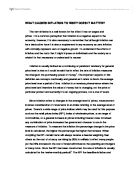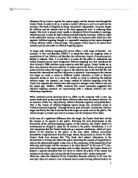The third cause of inflation is known as “wage price spirals”. This occurs when the workers suffer an increase in the cost of living. In order to maintain there original standard of living, they must demand a higher wage. Many firms have little or no choice and so accept. By paying higher wages, costs of production increase and companies are forced to raise the price level of their product. Higher goods prices means that workers will have to pay a larger percent of their wage on these goods. These extra costs force workers to yet aging demand an even higher wage as to keep their real wage constant, this is why this type of inflation is know as wage price spiral. The only way to prevent wage price spirals is when firms decline the worker’s demand for a wage increase, and workers have to accept the lower real wages.
The final cause of inflation is known as money supply inflation or the quantity theory of money. The essential idea of the quantity theory is that there is a close link between changes in the money supply and changes in inflation. The monetarist explanation of inflation operates the fisher equation;
MV = PT
money supply x velocity of circulation = price level x transactions or output
As monetarists assume that V and T are fixed, there is a direct relationship between the growth of money supply and inflation. Individuals can spend any excess money directly on goods and services; this has a direct impact on inflation by raising AD. The more elastic AS is in the economy, the greater the effect on inflation
Assess the extent to which UK Governments have successfully controlled inflation in recent years
The aim of the Government has always been to keep inflation low whilst maintaining low unemployment and high growth. Over recent years (roughly 1990 to 2003), there has been a dramatic change in the level of inflation, ranging from about 9.5% to 2%, a huge change in terms of inflation.
As can be seen by the graph below, before 1993, the UK has suffered large levels of inflation. In the 1980s, a change in the interest rate was the primary way to influence inflation. For example if expenditure (aggregate demand) is too high, inflation is high and the government reacts by increasing interest rates. However this had a bad effect in the short run in 1988, as mortgage repayment, resulting in a higher Retail Price Index. This increase of inflation then caused wage price spiralling, and inflation grew higher then ever. In order to overcome these high inflation rates, monetary policies were used. For a brief period, the government turned to the exchange rate as a means to control inflation and in 1990, the UK entered the European Exchange Rate Mechanism (ERM). Monetary policy had to be set to ensure that the pound did not strengthen or weaken by more than a certain amount against other currencies in the system. Unfortunately differences in economic conditions across Europe forced England out and they were forced to adopt a new idea.
In 1992, the public’s inflationary expectations changed and the rate of inflation had started to decrease more than previous levels. Instead of targeting something like the exchange rate as a means of controlling inflation, a rate for inflation itself was targeted. Interest rates were set to ensure demand in the economy was kept at a level consistent with a certain level of inflation over time. Inflation had already started to fall and when the “targeting regime introduced by Norman Lamont”, it appeared a very achievable idea. This type of inflation control is known as monetary policies.
Monetary policies are carried out by controlling the amount of money flowing around the economy; this is a tool which can be used to tackle inflation and any balance payment problems. Controlling interest rates to control the borrowing in the economy i.e. reduce the money in circulation and the value of the currency higher interest rates will attract overseas investment to put money into banks forcing up the value.
The decision as to whether to change interest rates in any one month is taken by the Monetary Policy Committee (MPC). This is a group of nine people, five from the Bank of England and the others are mainly professional economists. The MPC considers evidence about whether inflationary pressure is increasing, decreasing or remaining stable. If it believes that it is rising, it is likely to raise interest rates to reduce aggregate demand. If inflationary pressure is weak, it can cut interest rates to boost aggregate demand and allow unemployment to be reduced and output to increase. From 1992 to 1997, the Inflation target was controlled by a tight government monetary policy which depended upon the expectations of the employed. The first inflation target was set by the Chancellor of the Exchequer to be an annual inflation rate of 1%-4%, with an objective to be in the lower half of that range by the end of the 1992-97 parliaments. The inflation target was subsequently revised to be 2.5% or less.
Expectations were vital within the economy as if the money supply had fallen, AD would decrease and unemployment would increase due to the lack of belief/low expectations of the government. Friedman was the first man to realise the importance of these expectations and suggested that economic shocks to the economy could cause the SRPC to shift upwards resulting in higher levels of inflation at all levels of unemployment. The Phillips Curve (PC) is vital in evaluating inflation and states that employment, potential output and real wages are unaffected by inflation. If the government announced that the nominal money supply had fallen, then aggregate demand would fall along with the rise in the number of unemployed. The fall in the real money supply would lead to less wage push inflation.
In order to reduce inflationary expectations, we must look at the LRPC and the SRPC;
If the government considers that the nominal rate of money supply (I) is too high it must announce this to the public in an attempt to change expectations. If the government reduces to nominal rate of money supply growth (i), then in the short run, firms will have to honour previous wage settlements which reflect in the inflation rate I. As a result, there will be a fall in the money supply, aggregate demand will fall and the economy will move to point A. Inflation will fall quickly due to less wage push inflation causing a growth in the real money supply ( since inflation is lower than the nominal rate). Unemployment will decrease and push the economy to B and over time a new equilibrium will be reached.
The United Kingdom has enjoyed strong economic performance in recent years. Real growth has been high, unemployment rates have fallen to historically low levels, and inflation has remained low and close to the Government’s target. However this steady inflation is becoming too much and the economy is now weakening. But the strong monetary policies are insuring a steady economy. The first inflation target was set by the Chancellor of the Exchequer to be an annual inflation rate of 1%-4%, with an objective to be in the lower half of that range by the end of the 1992-1997. As seen by the graph on the first page, this target has been met and the monetary policy has worked particularly well. The MPC has been very successful, so to an extent that other countries have adopted the same policies. The very recent low inflation performance is certainly down in part to the decisions of the MPC when setting interest rates; the effects of the monetary tightening it started when it started raising interest rates in September 1999 are now beginning to come through. In addition to this, a Parliamentary Committee reviewing the performance of the MPC concluded that its quick action in the second half of 1998 helped the economy avoid a hard landing; this would suggest that the MPC has avoided high inflation and at the same time allowed the economy to run relatively quickly. However as inflation is low and stable, people’s expectations of inflation have decreased too, therefore presenting the possibility of instability in the future.
Also shown by the graph are the small disturbances within the 1.5% to 3.5% band. These are perhaps possibilities of small economic shocks possible caused by exogenous or endogenous goods (ones from outside the economy and inside the economy respectively). A good example of an exogenous shock is oil. It is clear that England is quite dependant on other countries for oil and so fluctuations in price/changes in quantity supplied has a strong effect on the UK economy. As prices rose in 2000, there was an inward shift in the AS curve causing upward price pressure.
Overall Inflation targeting appears to have provided a successful base from which to use monetary policies. However, indicators of long-term inflation expectations still seem to reveal doubts about whether current low inflation will continue into the future.







